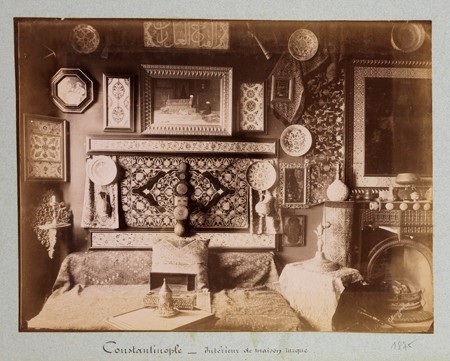The second half of the nineteenth century was a formative period for the creation of private collections of Islamic art in Europe and in Ottoman Istanbul. Yet little is known of the networks across these regions that facilitated the movement of precious works or about the role of artists in those processes. The book I have been writing during my CASVA fellowship is a cross-cultural study of collections by artists renowned for representing cultures of the Near East and of their role in international dealer networks. It proceeds from the idea that patterns and processes of collecting Islamic art are key to understanding the intertwined histories of art within the cultures of Europe and the Ottoman Empire.
Five artists are central to my study: Osman Hamdi Bey (Ottoman Empire, 1842–1910), Vasily Vereshchagin (Russia, 1842–1904), Stanisław Chlebowski (Poland, 1835–1884), Frederic Leighton (Britain, 1830–1896), and Jean-Léon Gérôme (France, 1824–1904). Each traveled widely and was a major player in networks through which precious manuscripts, costumes, ceramics, metalwork, woodwork, and even whole interiors were sourced from across the Ottoman Empire and sent to the Ottoman and European capitals. Displayed in the artists’ studios in Istanbul, Paris, London, Munich, and Moscow, this Islamic art was an important resource for their paintings, for fostering patronage, and for consolidating their reputations as cosmopolitan artists. After the artists’ deaths, some of these valuable collections entered public museums, while others remained in studios that were converted into house museums. I analyze the changing meanings of these objects as they moved from mosques and bazaars to artists’ studios and from exhibition halls into house museums and public collections.
Albert Goupil (1840–1884) has long been recognized as a major collector and tastemaker in the field of Islamic art in the French capital. The posthumous sale of his collection in 1888 formed the basis for the Musée des arts décoratifs (currently displayed in the Louvre). Yet despite his importance surprisingly little is known about how Goupil sourced Islamic art. The first part of my study, “Artist-Collector-Dealer,” reveals the transcultural art market networks that connected Goupil in Paris with his major collectors, such as the Rothschild family, and key Ottoman and expatriate artists in Istanbul. During my time at CASVA I have analyzed
The second part of my study, “Artists’ Studios and Cosmopolitan Masculinities,” focuses on what was being transacted when European and Ottoman painters displayed Islamic artifacts in the semipublic space of their studios. Frederic Leighton entertained visitors in the gold-domed Arab Hall created in his Holland Park home. This multisensory environment was a living equivalent to the aesthetic experience evoked on his canvases. The more peripatetic Vasily Vereshchagin designed semi-open-air studios in Munich, Paris, and later Moscow to showcase exotic artifacts amassed while traveling to
These practices were a means for consolidating a transcultural artistic identity. At his home and studio in Istanbul, replete with decorative art from the Ottoman Empire, China, and Japan, Osman Hamdi hosted the Ottoman Empire’s leading intellectuals as well as archaeologists and Ottoman and Orientalist artists. My book examines the significance of Islamic art in these sites of performative collaboration among artists, their models, and their patrons.
The final part of my study, “From Atelier to Museum,” addresses the diachronic dimension of the topic by focusing on the formation and later histories of Osman Hamdi’s and Frederic Leighton’s house museums. My study of these two museums in Turkey and Britain reveals their role in projecting concepts of national heritage through the cosmopolitan artistic biographies of their original owners. This comparative study focuses on the relationship between Orientalist and Ottoman artistic identities and museological practices. Analysis of public policy documents, museum mission statements, curatorial strategy, and education programming reveals the changing cultural significance of these institutions over time.
